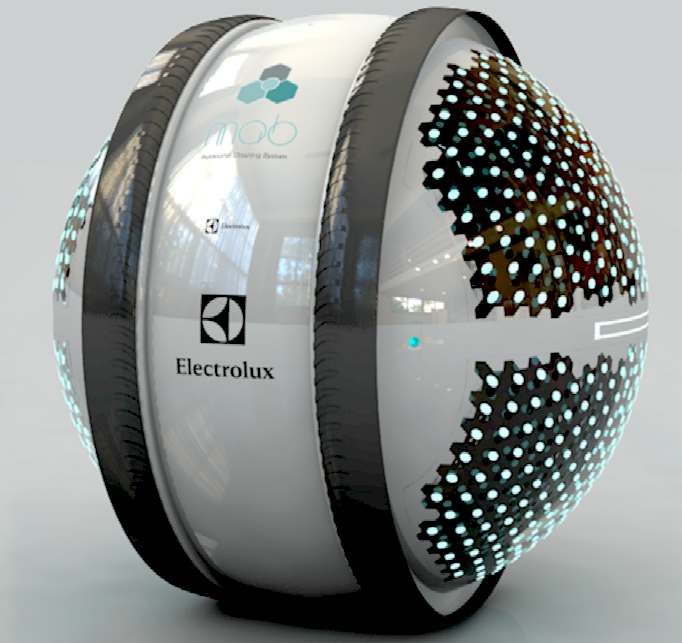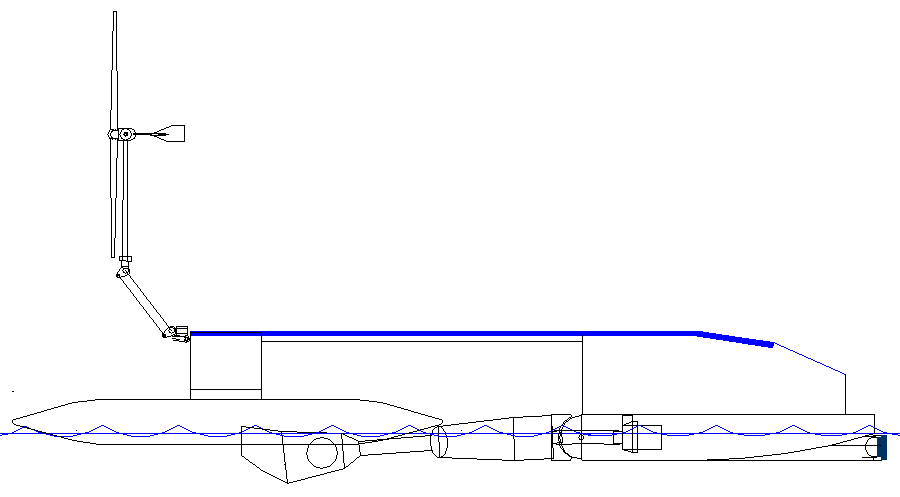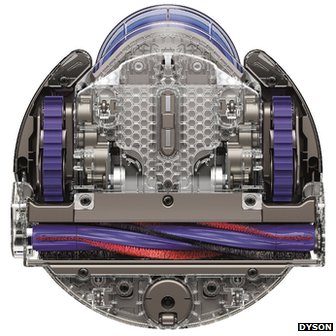|

I-Robot's
Roomba was introduced in 2002. As of Feb 2014, over 10 million units have been sold worldwide. Roomba features a set of basic sensors that help it perform tasks. For instance, the Roomba is able to change direction on encountering obstacles, to detect dirty spots on the floor, and to sense steep drops to keep it from falling down stairs. It uses two independently operating wheels that allow 360� turns in place. Additionally, it can adapt to perform other more creative tasks using an embedded computer in conjunction with the Roomba Open Interface.
Unlike the Electrolux Trilobite vacuuming robots, Roombas do not map out the rooms they are cleaning. Instead, iRobot developed a technology called iAdapt Responsive Cleaning Technology. Roombas rely on a few simple algorithms such as spiral cleaning (spiraling), room crossing, wall-following and random walk angle-changing after bumping into an object or wall. This design is based on MIT researcher and iRobot CTO Rodney Brooks's philosophy that robots should be like insects, equipped with simple control mechanisms tuned to their environments. The result is that although Roombas are effective at cleaning rooms, they take several times longer to do the job than a person would. The Roomba may cover some areas many times, and other areas only once or twice. The virtual wall accessories project beams which the Roomba will not cross.
A robotic vacuum cleaner, often called a robovac, is an autonomous robotic vacuum cleaner that has intelligent programming and a limited
vacuum cleaning
system. Some designs use spinning brushes to reach tight corners. Others combine a number of cleaning features (mopping, UV sterilization, etc.) simultaneous to vacuuming, thus rendering the machine into more than just a robot "vacuum" cleaner.
Robotic vacuums may be part of a more general purpose domestic robot. For example, some models integrate security cameras, intercom systems and other features. There can also be general caretaker service robots that have the ability to perform other basic housework tasks such as moving items, preparing food, and other cleaning in addition to vacuuming. The first robot cleaner to be put into production was
Electrolux Trilobite by the Swedish household and professional appliances manufacturer, Electrolux. In 1997, one of Electrolux's first versions of the Trilobite vacuum was featured on the BBC's science program, Tomorrow's World.
In 2001, the British technology company, Dyson (company) built and demonstrated a robot vacuum known as the DC06. However, due to its high price, it was never released to the market.
In 2002, the American advanced technology company, iRobot launched the Roomba floor vacuuming robot. Initially, iRobot decided to produce 15,000 units and 10,000 more units depending on the success of the launch. The Roomba immediately became a huge consumer sensation. By the Christmas season, iRobot produced 50,000 units to meet the holiday demand. After this success, major specialty retailers as well as more than 4,000 outlets such as Target, Kohl's and Linens 'n Things began to carry the Roomba.
Since 2002, new variations of robotic vacuum cleaners have appeared in the market. For example, the Canadian bObsweep robotic vacuum that both mops and vacuums, or the Neato Robotics XV-11 robotic vacuum, which uses laser-vision rather than the traditional ultrasound based models.


LEFT
- The Electrolux Trilobite is a robotic vacuum cleaner from the famous Swedish domestic
consumer company. The prototype cleaner was first seen on the BBC television programme, "Tomorrow's World", in 1997, when it was demonstrated by presenter Philippa Forrester. It was the world's first commercially available autonomous vacuum cleaner, introduced as a product in 2001.
The Trilobite contains a vacuum cleaner and a removable roller brush capable of working on deep-pile carpet. It has the ability to map rooms and avoid obstacles by using ultrasonic sensors (on the Mark 2 model also infrared). It recharges itself on a charging base, which it automatically finds when
it has completed its cleaning task or its power runs low. The Trilobite will indicate when the dustbin needs to be emptied.
Its ultrasonic sensors allow it to come within 1" of objects without colliding with them.
RIGHT
- Flying mini-robot cleaners win Electrolux Design Lab 2013 Contest. Stefano
Marzano, Chief Design Officer at Electrolux and Head of Jury is quoted as
saying: �This year�s winning concept renews the idea of looking at the robot, seeing it not as one unit that mimics a person, but instead as something inspired by the magical logic of nature�s collaborative efforts and group
intelligence.� �The Mab is an innovative concept which could be relevant to minimize the daily cleanings efforts of consumers as well as businesses, while maximizing the results�
BBC
NEWS SEPT 2014 - ROBOT VACUUM CLEANER GOES ON SALE British engineering company Dyson has announced its first robot vacuum cleaner at an event in
Tokyo.
The Dyson 360 Eye joins a crowded market - Hoover, iRobot, Samsung, Neato and Vileda are among other manufacturers to sell such products.
But the Cotswolds-based company says its machine has more powerful suction and should be better at spotting dirt thanks to a "unique" camera system.
One expert said the claims sounded "quite compelling".
"If it works as well as Dyson says it does, then this could be the robot vacuum cleaner to get mainstream market penetration, and not just be a niche product," said Will Findlater, who covers technology for Stuff magazine.
"Up until this point robot vacuums have been objects of geek affection.
"Certainly our experience of the competitors has been that they may do more on the robotics side of things than they do on the rather important business of cleaning your floors."
The machine is due to go on sale in Japan in the first three months of 2015, and then elsewhere later in the year.
Dyson previously showed off another robot vacuum cleaner - the DC06 - in 2001, but cancelled the project a few years later, in part because it would have cost consumers $3,000 (�1,820) or more.
It has yet to announce the price of the new model.
According to Dyson, most other robot vacuums use "weak, inefficient motors" in order to conserve
battery life.
By contrast, it uses the same V2 digital motor found in its other handheld vacuum cleaners, and combines it with a brush bar that covers the full width of the machine, rather than relying on side sweepers.
"We've been developing for a number of years some of the smallest and most powerful digital motors available, and getting that right has enabled us to give the machine very powerful suction, so it can have a very high performance clean," Nick Schneider, a design engineer at the company, told the BBC.
"In addition we've developed a vision system that enables the machine to be very methodical in its clean and not miss sections of floor space."
The vacuum is fitted with a panoramic lens, which sits on top of a camera that captures 360-degree views at 30 frames a second. This is combined with data from infrared sensors to let the machine's internal
computer make sense of its position and surroundings.
Another innovation is the ability to schedule a clean remotely via an Android or iOS app.
Although other robot vacuums tend to have less suction power than human-directed vacuums, they make up for this by taking several passes at each room. So, it remains to be seen if Dyson's model actually leaves owners with cleaner homes.
Mr Schneider also acknowledged that the new machine remained less powerful than his company's plug-in-and-push models, meaning it would take longer to do a big clean. But he said it might still be the preferable option for families with a house layout that suited the automated tech.
"We're a way off in terms of comparing it to our corded machines," he said.
"But the benefit that it has is that you don't have to be there to use it.
"So, perhaps even if the performance isn't quite what you'd expect from a DC41 [full-size upright vacuum], the benefit of the convenience of just being able to set it whenever, and not having to worry about it, I think, is its real appeal."
Dyson's robot vacuum competitors are not resting on their laurels.
American firm Moneual has a new model that adds a wet mop to help clean hard floors.
Samsung's latest release allows owners to steer it to dirty spots by shining a
laser pointer on the ground, which it then trundles towards.
LG's newest machine can send photos of its surroundings to its owner's
smartphone, allowing them to check if its done its job properly and order another pass if not.
And Toshiba's Torneo Robo empties the dirt its gathers into its dock, allowing it to keep working without
human intervention for extended periods of time.

THE
WORLD'S LARGEST VACUUM CLEANER
- The above is a proposed trimaran test rig, using the above off-the-shelf
components, just to get a feel for the concept. This is in no way a complete
solution, but then we have to start somewhere. What we learn from these
small scale experiments, could eventually help us to formulate a dual
purpose, ocean capable cruiser, to clean up the English Channel and local
harbors, with a view to cleaning up the marine environment and improving
the quality of beaches and locally caught fish, etc. Full size, this
autonomous vessel could harvest up to 50 tons of plastic,
before it needs to offload. How many Electrolux vacuum cleaners would 50
tons make?
WIKIPEDIA
A - Z OF ROBOT VACUUM CLEANERS
A
robotic vacuum cleaner is an autonomous
robot machine that has intelligent programming and usually, a restricted
cleaning capacity. Some designs combine a number of cleaning features
(mopping, UV sterilization, etc.) simultaneous to vacuuming, thus rendering
the machine into more than just a robot "vacuum" cleaner.
Abitelax
AJC-32J
ANABAS
SZ-200,SZ-300,SZ-350
bObsweep
CCP
Laqulito
CCP
SO-Zi
Dustbot
Electrolux
Trilobite
Figra
F.Robo
clean
Fuji
and Sumitomo
Office
area cleaning robot system
Iris
Ohyama RBC-28
K�rcher
RC3000
Koolvac
LG
Roboking
Neato
XV-11
Orazio
(vacuum cleaner)
PicaBot
Roomba
Sun
Ruck I YOU SR-RC01R
Sharp
COCOROBO
Three
up MOPPY
Toshiba
TORNEO ROBO
Tsukamoto
Aim ecomo
AIM-ROBO1
AUTOBOT 

| Rating |
|
|
|
|
|
|
|
|
|
|
General
|
| Operating
Time (min) |
60 |
100 |
60 |
120 |
60 |
60 |
40 |
60 |
120 |
120 |
120 |
| Charging
Time (min) |
150.0000 |
180.0000 |
210.0000 |
180.0000 |
150.0000 |
150.0000 |
180.0000 |
150.0000 |
180.0000 |
120.0000 |
120.0000 |
| Room
Coverage |
5.0000 |
3.0000 |
2.0000 |
5.0000 |
5.0000 |
5.0000 |
4.0000 |
5.0000 |
5.0000 |
4.0000 |
4.0000 |
| Dust
Bin Capacity (ml) |
660 |
700 |
300 |
500 |
660 |
660 |
0 |
660 |
500 |
550 |
550 |
| Sound
Level (db) |
70 |
60 |
70 |
60 |
70 |
70 |
60 |
70 |
60 |
70 |
70 |
Features
|
| Cleaning
Cloths |
No |
No |
No |
No |
No |
No |
No |
No |
No |
Yes |
Yes |
| Side
Brush |
0 |
2 |
1 |
1 |
0 |
1 |
0 |
0 |
1 |
2 |
2 |
| Continues
Cleaning Once Re-Charged |
Yes |
No |
No |
No |
Yes |
Yes |
No |
Yes |
No |
No |
No |
| Full
Bin Indicator |
Yes |
Yes |
No |
Yes |
Yes |
Yes |
No |
Yes |
Yes |
No |
No |
| Collision
Detection |
Bumper |
Light
Touch Bumper |
Bumper |
Light
Touch Bumper |
Bumper |
Bumper |
Bumper |
Bumper |
Light
Touch Bumper |
Obstacle
Sensor |
Obstacle
Sensor |
| Room
Differentiation |
RPS
and Boundary Markers |
Boundary
Markers |
None |
Lighthouse
Technology |
RPS
and Boundary Markers |
RPS
and Boundary Markers |
Virtual
Guard |
RPS
and Boundary Markers |
Lighthouse
Technology |
None |
None |
| Scheduling |
Onboard |
Onboard |
Onboard |
Onboard |
Onboard |
Onboard |
N/A |
Onboard |
Onboard |
Delayed/Deferred
Cleaning |
Delayed/Deferred
Cleaning |
| Self-Charging
Base |
Included |
Included |
Included |
Included |
Included |
Included |
N/A |
Included |
Included |
Included |
Included |
| Remote
Control |
N/A |
Included |
Included |
Included |
N/A |
N/A |
N/A |
N/A |
Included |
Included |
Included |
| Odor
Removal |
No |
No |
Yes |
No |
No |
No |
No |
No |
No |
No |
No |
| UV
Light Disinfection |
No |
No |
Yes |
No |
No |
No |
No |
No |
No |
No |
No |
Accessories
|
| Virtual
Walls |
0 |
0 |
0 |
3 |
0 |
0 |
2 |
0 |
2 |
0 |
0 |
Dimensions
|
| Height
(cm) |
10.1 |
9.6 |
9 |
9.2 |
10.1 |
10.1 |
9.1 |
10.1 |
9.2 |
9 |
9 |
| Diameter
(cm) |
33 |
33.6 |
35 |
35 |
33 |
33 |
37.6 |
33 |
35 |
35 |
35 |
| Weight
(kg) |
5 |
3 |
3 |
3.85 |
5 |
5 |
3.9 |
5 |
3.85 |
2.8 |
2.8 |
Help & Support
|
| Warranty |
5
Years |
5
Years |
5
Years |
5
Years |
5
Years |
5
Years |
1
Year |
5
Years |
5
Years |
5
Years |
5
Years |
|
LINKS
Treehugger
vacuum cleaners made from ocean plastic highlight ugly pollution beautiful
design
Electrolux
Vac-from-the-sea
Techcrunch
2010 Electrolux will clean the oceans of plastic debris then make vacuum
cleaners
Earthtimes
vacuums-ocean-plastic
Plastics
today bottles utilize plastic scrap retrieved pacific gyre
Bigthink
cleaning up the oceans with a vacuum cleaner
Aquarium
vacs_from_the_sea_on_exhibit_at_the_two_oceans
Electrolux
group flying mini robot cleaners win electrolux design lab competition 2013
Wikipedia
domestic_robot
Wikipedia
robotic_vacuum_cleaner
Wikipedia
robotic_mapping
http://en.wikipedia.org/wiki/Robotic_mapping
http://en.wikipedia.org/wiki/Domestic_robot
http://en.wikipedia.org/wiki/Robotic_vacuum_cleaner
http://www.electroluxgroup.com/en/flying-mini-robot-cleaners-win-electrolux-design-lab-2013-contest-18007/
http://www.aquarium.co.za/blog/entry/vacs_from_the_sea_on_exhibit_at_the_two_oceans_aquarium/
http://www.plasticstoday.com/articles/bottles-utilize-plastic-scrap-retrieved-pacific-gyre0916201101
http://bigthink.com/design-for-good/cleaning-up-the-oceans-with-a-vacuum-cleaner
http://www.electrolux.co.uk/Innovation/Campaigns/Vac-from-the-sea1/
http://www.electrolux.co.uk/Innovation/Campaigns/Vac-from-the-sea1/Articles/FAQ---about-Vac-from-the-Sea/
http://techcrunch.com/2010/06/24/electrolux-will-clean-the-oceans-of-plastic-debris-then-make-vacuum-cleaners/
http://www.earthtimes.org/business/vacuums-ocean-plastic/24/
|





